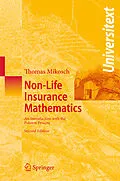The volume offers a mathematical introduction to non-life insurance and, at the same time, to a multitude of applied stochastic processes. It includes detailed discussions of the fundamental models regarding claim sizes, claim arrivals, the total claim amount, and their probabilistic properties. Throughout the volume the language of stochastic processes is used for describing the dynamics of an insurance portfolio in claim size, space and time. Special emphasis is given to the phenomena which are caused by large claims in these models. The reader learns how the underlying probabilistic structures allow determining premiums in a portfolio or in an individual policy.
The second edition contains various new chapters that illustrate the use of point process techniques in non-life insurance mathematics. Poisson processes play a central role. Detailed discussions show how Poisson processes can be used to describe complex aspects in an insurance business such as delays in reporting, the settlement of claims and claims reserving. Also the chain ladder method is explained in detail.
More than 150 figures and tables illustrate and visualize the theory. Every section ends with numerous exercises. An extensive bibliography, annotated with various comments sections with references to more advanced relevant literature, makes the volume broadly and easily accessible.
Autorentext
Thomas Mikosch has been professor at the Laboratory of Actuarial Mathematics of the University of Copenhagen since January 2001. Before this, he held positions in Dresden (Germany), Wellington (New Zealand) and Groningen (Netherlands). His special interests are applied probability theory and stochastic processes. Over the last few years his research has focused on extremal events in finance, insurance and telecommunications. His earlier very successful book, written jointly with Paul Embrechts and Claudia Klüppelberg, Modelling Extremal Events for Finance and Insurance (1997), is also published by Springer.
Zusammenfassung
The second edition of this book contains both basic and more advanced - terial on non-life insurance mathematics. Parts I and II of the book cover the basic course of the ?rst edition; this text has changed very little. It aims at the undergraduate (bachelor) actuarial student as a ?rst introduction to the topics of non-life insurance mathematics. Parts III and IV are new. They can serve as an independent course on stochastic models of non-life insurance mathematics at the graduate (master) level. The basic themes in all parts of this book are point process theory, the Poisson and compound Poisson processes. Point processes constitute an - portant part of modern stochastic process theory. They are well understood models and have applications in a wide range of applied probability areas such as stochastic geometry, extreme value theory, queuing and large c- puter networks, insurance and ?nance. The main idea behind a point process is counting. Counting is bread and butter in non-life insurance: the modeling of claim numbers is one of the - jor tasks of the actuary. Part I of this book extensively deals with counting processes on the real line, such as the Poisson, renewal and mixed Poisson processes. These processes can be studied in the point process framework as well, but such an approach requires more advanced theoretical tools.
Inhalt
Collective Risk Models.- The Basic Model.- Models for the Claim Number Process.- The Total Claim Amount.- Ruin Theory.- Experience Rating.- Bayes Estimation.- Linear Bayes Estimation.- A Point Process Approach to Collective Risk Theory.- The General Poisson Process.- Poisson Random Measures in Collective Risk Theory.- Weak Convergence of Point Processes.- Special Topics.- An Excursion to L#x00E9;vy Processes.- Cluster Point Processes.
